The IBM 610 Auto-Point Computer – The first "personal computer".

↑ NEW: color photos... CLICK to see. NEWER: Reader comments at end.
The IBM 610 Auto-Point Computer was designed in the portholed attic of Watson Lab at Columbia University by John Lentz between 1948 and 1954 as the Personal Automatic Computer (PAC) and announced by IBM as the 610 Auto-Point in 1957[1]. The IBM 610 was the first personal computer in the sense that it was the first computer intended for use by one person (e.g. in an office) and controlled from a keyboard[2]. The large cabinet contains a magnetic drum, the arithmetic control circuitry, a control panel, and separate paper-tape readers and punches for program and data (according to one former user, Russ Jensen, "The machine was programmed by a punched paper tape which duplicated itself in order to perform extra passes through the code". The IBM electric typewriter printed the output at 18 characters per second; the other device was the operator's keyboard for control and data entry, which incorporated a small cathode ray tube (two inches, 32×10 pixels) that could display the contents of any register [4]. A "register" is any of 84 drum locations (31 digits plus sign). The control panel provides additional programming control (e.g. for creating subroutines, typically for trigonometric or other mathematical functions). Price: $55,000.00 (or rental at $1150/month, $460 academic). 180 units were produced.
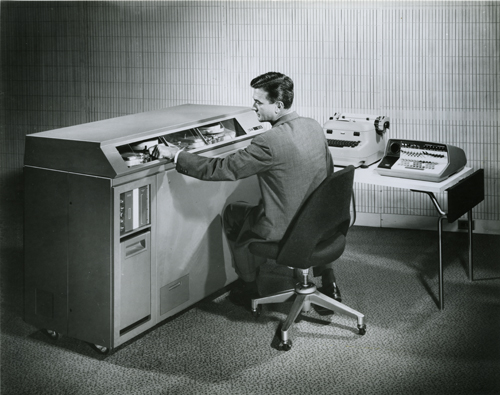 Lentz said of the 610, "A novel approach to computer
programming and control, used in the IBM 610 computer, allows the
solution of complex problems by an operator whose only previous experience
with computing has been the desk calculator. The machine's command structure
is designed so that the operator can at all times communicate with the
computer by a series of short sentence-type instructions closely resembling
the steps of manual arithmetic solution. A type of floating-decimal
operation called the 'auto-point' mode permits entry of data into storage
locations with automatic positioning of the decimal point, without elaborate
programming. The decimal point is automatically re-positioned during
subsequent computation" (Reference 1).
Lentz said of the 610, "A novel approach to computer
programming and control, used in the IBM 610 computer, allows the
solution of complex problems by an operator whose only previous experience
with computing has been the desk calculator. The machine's command structure
is designed so that the operator can at all times communicate with the
computer by a series of short sentence-type instructions closely resembling
the steps of manual arithmetic solution. A type of floating-decimal
operation called the 'auto-point' mode permits entry of data into storage
locations with automatic positioning of the decimal point, without elaborate
programming. The decimal point is automatically re-positioned during
subsequent computation" (Reference 1).
Users said (Reference 2) the machine was affordable, reliable (95% uptime was typical), easy to program (it was one of the first — if not the first — computer that was programmable symbolically from a keyboard), handled floating-point arithmetic naturally, and did not require air conditioning or special power. Some, however, faulted it for its execution speed (e.g. 20 seconds to calculate a sine). But as Brennan says, "Far ahead of its time conceptually, the 610 presaged 'on-line' direct communication between individual and computer." When the 610 was discontinued (it was technologically obsolete from the start, due to the long delay in getting it to market), most sites replaced it with a 1620.
IBM produced several other personal computers in later years, including the 5100 and the CS-9000 before
finally releasing its world-conquering PC in
1981 (the CS-9000 was ready before the PC but announced after it).
__________________
- Brennan
[9] says the first 610 prototype
was "completed at Watson Lab in 1948".
Grosch [59]
says "Lentz's 610 did not exist even in prototype when I left in 1951
—- if 'under wraps', the wrapping was much later." According to
Bashe [4], the first engineering
model of the Auto-Point Computer was operational in 1954, but release was
delayed by IBM's rollout of its 650 and 700-series computers. The 610 was
IBM's second-to-last vacuum tube computer.
- Sometimes the refrigerator-size Bendix G-15 (1956) is called the "first personal computer", but the 610 was running at least two years earlier. In any case the 610 was intended to be personal, whereas the G-15 was intended to be inexpensive [59].) (Another device sometimes named the first personal computer is Simon — also associated with Columbia University! — but it was a limited-function demonstration device.
For reasons lost in time, the construction of the first 610 prototypes was farmed out to Burroughs/ElectroData in Pasadena, CA, which also made contributions to the design. In May 2004, I received the following comments from John C. Alrich, who was on the 610 design team at Burroughs, and worked with Lentz for 12-18 months in Pasadena on the project:
I was on the design team from Burroughs. In fact, I had a patent on part of the drum design. John was indeed the architect but Burroughs, Pasadena, played no small part in the design and building of several of the prototypes. The only printed data I have from that project is my patent which was filled 4/14/55 and issued 9/17/57, so April '55 must have been in the middle of our design phase in Pasadena. I have no other documents. I do remember Herb Grosch coming out and looking at the machine when it was well along [John, with Jack Palmer, also of IBM, had been up half the night getting the square root function to work for this demo; the 610 was the first IBM product with built-in square root capability*.I don't remember whether we were part of Burroughs yet or still a subsidiary of Consolidated Electrodynamics Corporation, called ElectroData. CEC manufactured mass spectrometers and our first computer was designed to invert large matrices that were used in compound analysis. The guy that pushed CEC into the computer business was Clifford Berry, who designed mass spectrometers, and who — are you ready for this — got his Ph.D. under Atanasoff before World War II and worked with Atanasoff on his first computer there at the University! Cliff did not work on our first computer, called the Datatron 201, but continued with designing mass spectromters. I think Cliff died in the late fifties at an early age.
John's design was radically different from the CEC/von Neumann design I was familiar with in that the circuitry was dynamic rather than static; i.e. he used free-running multivibrators rather than static flip-flops for his logic. He did not think ff's were stable! I can go into more of that later.
The other strange thing in the design (to me at least) was that the 610 was essentially a Turing machine; i.e., in principle, it had infinite capacity for input data and for intermediate and final output data. The means, of course, was punched paper tape, both working, as I recall, at 18 characters/second! The small plated drum was also used to store intermediate results. John used lots of wire relays in his design too.
Why I was assigned to the project by L.P. Robinson (Robbie), I'll never know. I was not a circuit person although, from 1951-52 I worked under a brilliant mathematician, Ernst Selmer, who was the #2 mathematician in Norway and was working with von Neumann's group before he came west to teach at Cal Tech for a year or so. So I knew logic design pretty well (I designed the Floating Point Control for the Datatron in 1957, the most satisfactory piece of design I did in a career of 40 years).
It was interesting to read that IBM made 180 units, about which I have only two comments:
- Because of the dynamic circuitry, if the clock lost synchronization, you couldn't hold a fixed image on a 'scope screen to do any debugging; and
- When this happened, Lentz was one of the few people in the world who could analyze the trouble and fix it.
I wonder how IBM's Field Service managed? On re-thinking about the 610, I still find it an enigma. There were a lot of clever ideas in it, mostly John's, but I think John went up the wrong limb of the computer evolution tree. In principle, his machine could solve any mathematics problem that could be solved in finite time but by using relay trees and paper-tape I/O, the speed of execution was intolerably slow, even by 1955 standards.
| * | The Aberdeen Relay Calculator (1944) did square roots too, but it was not a product on the open market. |
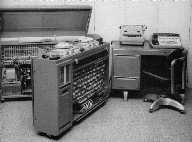 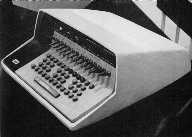 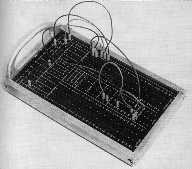
|
John Alrich comments (June 2004): "In many ways the 610 was unique or nearly unique for its day or any other day. One attribute in particular was the method of numerical encoding. As I recall, each word was fifteen digits long using pulse position encoding. That is, each of the fifteen digits was twelve serial slots long. Depending upon where a pulse or pulses appeared within each digit determined the value of that digit, the sign of the word and the decimal location. Therefore the serial display was rather simple — a CRT with a single modulated beam. A transparent engraved reticle, with 180 small slots, placed in front of the CRT allowed the user to read out immediately the numeric value of the word being displayed.
"I think with pulse-position modulation it becomes fairly obvious how certain arithmetic operations are performed. Since the 610 was non-Boolean, arithmetic operations were generally done by counting rather than with Boolean logic. Using the drum for temporary storage, during an add, for example, the addend and the augend are simultaneously available in serial form. The add operation probably was done something like the following: The addend and the augend were read off the drum in synchronization serially, least significant digit first. In between clocks on the drum (enclosing a full word), each digit of the augend was counted down at a high rate to zero while each digit of the addend was counted up, with carry noted for inclusion while counting the next digit. In this way the sum was determined within one word time of the drum revolution. Subtraction could be performed in a similiar way replacing the carry with a borrow; multiplication, division and square-root were, of course, more complex."
John relates that the people at Burroughs called the 610 the CADET
("Can't Add, Doesn't Even Try"), the same term used by IBMers for the
1620. For more about John's experiences at
Burroughs see:
- http://www.smecc.org/jack_l__aldridge.htm
- http://www.smecc.org/john_alrich_-_burroughs.htm
- http://www.smecc.org/burroughs.htm
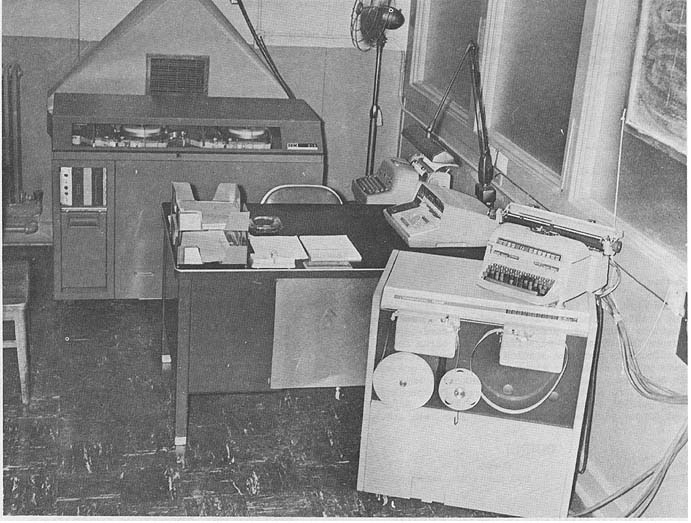 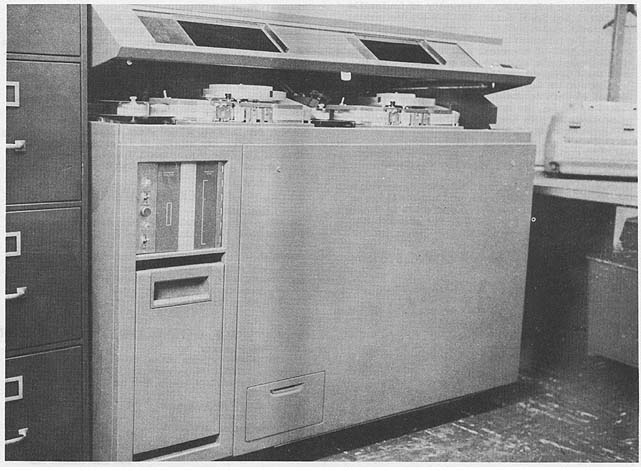
|
Photos: From Reference 2, scanned by Ed Thelen. Click on images to enlarge.
Reader Comments
Bill McKeeman writes on 5 January 2021:I read your article on the IBM 610. Here are some personal experiences.The United States Naval Academy was given an IBM 610 in 1960/1961.
At that time I was an officer Instructor in Physics. The computer itself was installed in Dahlgren Hall (not in the Science Building). I taught myself to program the computer. I do not remember anyone else knowing how to use it at the time. As mentioned in your article, the IBM-supplied sine function was very slow. In fact there was a plug-panel which contained various means to speed up computation. As it turned out, the IBM 610 could much more rapidly compute sine from Taylor Series than from the plug-panel. I eventually punched a series of short tapes which could be inserted into any program needing trigonometric functions rather than use the IBM-supplied capabilities. Scotch tape was used to paste segments together to make longer programs. A loop was achieved by taping together the ends of the punched-tape for a single iteration. Loops failed when the hole-sampling pins finally wore through the paper. So backup tapes were kept, then copied for the next runs.
I was also a part-time graduate student at The George Washington University in D.C., completing my MA in Mathematics in 1961. Among the programs I wrote for the IBM 610 were the volume of the N-dimensional simplex and N-dimensional sphere for increasing N. Professor Pinkston, head of the Physics Department, asked me to print tables to uniformly adjust the grades given to students, which had to have a mean value of 2.8 (grade C) regardless of the actual scores on examinations. He gave me the formulas and I gave him a set of tables which were then used by the staff to adjust the grades to the allowable values. After each exam, the (sophomore) students clustered around Joe Bellino, All-American Quarterback. So long as they did better than he did, they were guaranteed to pass.
/s/ Bill (Dr. William Marshall McKeeman)
- Video:: IBM Auto-Point Computer History 1957 - A Rare Look Back - IBM's First Personal Computer?, Computer History Archive Project, 2019.
- Lentz, John, "A New Approach to Small-Computer Programming and Control", IBM Journal of Research and Development, Vol.2, No.1, p.72 (1958).
- Weik, Martin H., A Third Survey of Domestic Electronic Digital Computing Systems, Report No. 1115, US Army Ballistic Research Laboratories, Aberdeen Proving Ground, Maryland (March 1961).
- Grosch, Herbert R.J., Computer: Bit Slices from a Life, Third Millenium Books, Novato CA (1991), ISBN 0-88733-085 [3rd ed mss)].
- Brennan, Jean Ford, The IBM Watson Laboratory at Columbia University: A History, IBM, Armonk NY (1971)
- Bashe, Charles J.; Lyle R. Johnson; John H. Palmer; Emerson W. Pugh, IBM's Early Computers, MIT Press (1985).
- IBM 610, in Martin H. Weik, A Third Survey of Domestic Electronic Digital Computing Systems, Ballistic Research Laboratories Report No. 1115, March 1961, Aberdeen Proving Ground, Maryland.
- The Charles Babbage Institute lists an IBM 610 manual among its holdings.
Onsite Links:
- John Lentz.
- Grosch Chapters 10 and 12.
- Brennan, pp.15, 18-19, 43, 49.
- Watson Lab at Columbia University.
- IBM Calculators
Offsite Links (valid as of 29 April 2009):
- IBM 610 Auto-Point Computer (IBM history archive)
- IBM 610 Auto-Point Computer Operator Manual, IBM, 1957.
- IBM 610 Autopoint Computer specifications.
- Inventory of Computers Within the U.S. Army Ordnance Corps, FY 1961
- Vannevar Bush's July, 1945, Atlantic Monthly article presaging the modern personal computer: As We May Think.
- Agora Exhibition at Jyväskylä University, Finland (suggests that an IBM 610 might be on display in the university's Technology Center).
Translations of this page courtesy of...
| Language | Link | Date | Translator | Organization |
|---|---|---|---|---|
| Belarusian | Беларуская | 2023/08/21 | Vladyslav Byshuk | Владислав Бишук | studycrumb.com |
| Chinese (traditional) | 繁體字 | 2019/08/28 | Austin Cole | MattressMoz.com |
| Finnish | Suomi | 2023/08/31 | Kerstin Schmidt | https://writemyessay4me.org/ |
| French | Français | 2023/08/31 | Kerstin Schmidt | prothesiswriter.com |
| German | Deutsch | 2023/08/31 | Kerstin Schmidt | writemypaper4me.org |
| Italian | Italiano | 2023/08/31 | Kerstin Schmidt | https://admission-writer.com/ |
| Polish | Polski | 2019/11/30 | Grzegorz Adamski | odealo.com |
| Romanian | Română | 2023/08/21 | Vladyslav Byshuk | Владислав Бишук | studybounty.com |
| Russian | Русский | 2023/07/16 | Alexey | Plastic Recycling Company |
| Swedish | Svenska | 2023/08/31 | Kerstin Schmidt | justdomyhomework.com |
| Spanish | Español | 2023/08/31 | Kerstin Schmidt | https://pro-academic-writers.com/ |
